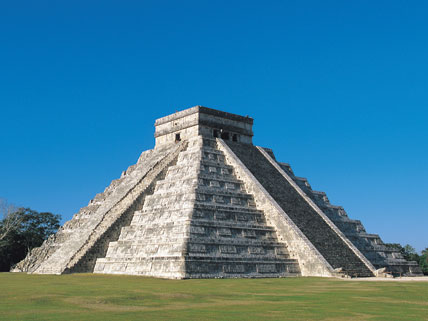The Maya Temple of Kukulkan, often called “El Castillo” (the castle), is a step pyramid at the Chichen Itza site in Mexico’s Yucatán Peninsula; it dates from the Early Post-Classic period.
Archaeologists have a habit of breaking down the tidy labels on time lines, so that what we think we know is constantly subject to revision. Discoveries at a huge complex of Maya sites provide an example. The traditional view of Maya history highlights the Classic period (c. 250–900 CE), an era during which Maya civilization and its characteristic monumental architecture are said to have developed fully. The long Preclassic period (2000 BCE–250 CE) has been seen as a formative period. However, new discoveries at a huge complex that had formerly been labeled Preclassic refute this standard account.
Central America’s Mirador basin makes up 2,475 square miles of jungle in northern Guatemala and southern Mexico. Some 30 Maya cities occupied the basin; the region’s capital, El Mirador, covered six square miles. Remains of causeways, terraces, temples, pyramids, and other structures still loom over the flat terrain. The basin’s interconnected cities may have been home to a million people. The pyramid called La Danta, which is located there, is particularly gigantic. Though only 230 feet high, it may in fact be more massive than Egypt’s Great Pyramid at Giza. Calculations estimate its mass to be 99 million cubic feet of rock and filler.
Such monumental architecture doesn’t jibe with conventional wisdom that such building was achieved only in the Classic period. Yet the Mirador basin, which flourished long before the Classic Maya period, remains overshadowed by more well-known, though smaller, Classic Maya sites, such as Tikal.
Image credit: Goodshoot/Jupiterimages/Getty Images
Related Links
- El Mirador, the Lost City of the Maya
This Smithsonian magazine web site details in text and visuals the exciting archaeological explorations of the Mirador basin.
(Source: Smithsonian, April 2011) - Authentic Maya: Mirador Basin, Petén
This Web site provides background about El Mirador, Guatemala, and other ancient Maya sites; includes picture galleries and a videotaped university lecture by Prof. Richard Hansen. (Source: authenticmaya.com; accessed May 5, 2011) - The Rise and Fall of the Maya Empire
View videos and photos related to the Maya at History.com. (Source: History.com; accessed May 5, 2011)





hahahaha
amazing
lol
Please teach the rest of these internet hooligans how to write and reasecrh!
Oh my gosh!! Tikal!!
cool! B) ><
me too
how is it cool?
this website bores me. im on dis cuz of school
This is fascinating; the maya metropolis who could have found this temple and what made the scientist or geologist decide to remove this type of view, excitement and obtain such information from the world; this type of site is like a tourist site, someone would love to take pictures and write about this type of places.
this article is about maya temple how they study the habit and how they breaking down the tidy.they discover a huge complex
has anybody been in the castle to observe how old it really could be
this is stupid
You people need to learn how to appreciate discoveries like this! Dont be stupid! And hjkjkwinkymac23, dis? really!?
what would they find next and why
help read my name!!!!!!!!!!!!!!